
IMPORTANT!
This Sacred Sites Journey to MALTA is being rescheduled to March 22 -
28, 2015.
The itinerary below will be updated soon.
We're working hard to keep the pricing the same as posted for the November 2014 departure.

TOUR DESCRIPTION
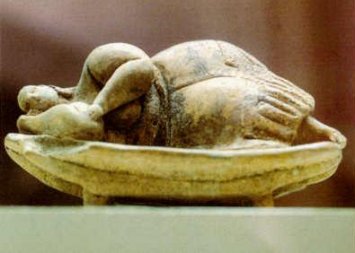
Explore
and experience the powerful transformational energies
of the ancient megalithic Mother Goddess temples,
some of the oldest free-standing structures on Earth - over 7,000 years old!
Participate in meditations and ritual to step back in “time”
as you connect with the still palpable energies of these amazing sacred sites that were in
use
when the Mother Goddess was center stage in the hearts and minds of the people who built
them!
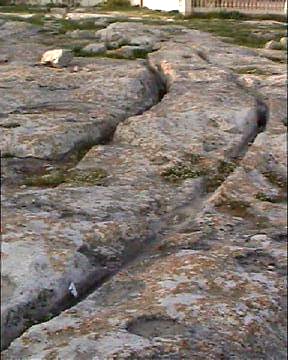
Also
explore the mysterious ancient “cart ruts” that have been the subject of debate
for hundreds of years
as to their origin, form and function - one of the most perplexing mysteries of ancient
megalithic building technologies of all time!
SPECIAL HIGHLIGHT

Private entrance for our group at the Hypogeum

TOUR
PERSONNEL
Featured Speaker Debra
Keil-Leavitt

Author, Astrologer and Mythic
Historian
Debbie was a participant during our
April 2013 tour to Malta.
And has also been to Egypt with us!
Debbie Keil-Leavitt,
CAP, has been a practicing astrologer since 1972. She is the former Pres.
of the Aquarian Organization of Astrologers in Kansas City. Debbie has lectured
and led workshops on varied subjects since 2002, and has appeared in various
publications worldwide including regularly published articles and blogs for the California
Psychics blog/newsletter: http://blog.californiapsychics.com/. She also has published
works in the International Society for Astrological Research Journal and weekly Ezine.
Debbie’s astrological article on Beach Boy Dennis Wilson appeared in the Endless
Summer Quarterly. Her interview with The Kansas City Star Magazine was featured in the
December 18th, 2012 issue.
Debbie has spoken on various educational/inspirational trips to Greece,
Egypt and Malta. She resides in Kansas City, Missouri while also enjoying a
location in Baja California. For information on upcoming classes, events & tours, or
to enjoy personal consultation from Debbie, contact: http://www.debbiekeilastrologer.com/
An Invitation from Debbie:
Dear Fellow Sacred Travelers
I am so thrilled to be sharing rich, magical Malta with you, my current and future
friends! As an avid traveler, I can assure you that Malta is a truly powerful and unique
place on our planet. You will never be quite the same once you touch, feel and
“breathe in” this mysterious ancient culture of astronomers/astrologers and
goddess/priestesses. The sights and sounds of these “dots on the map” south of
Sicily and east and north of Tunisia will introduce you to our brilliant, enigmatic
ancestors in the midst of a nearly perfect Mediterranean climate and incredible food. The
layers of history will make you aware of your timeless spirit on a beautiful Mother
planet.
In 2012, I had been reading everything I could find about the wonderful work that the
people of Malta had been doing to uncover and preserve their unique, prehistoric culture.
I was stunned to find that there were beautiful stone structures older than the Great
Pyramid and Stonehenge with magical acoustical qualities. I could see the lovely influence
of the mysterious Minoans, yet their sacred sites appeared to be built in homage, and
adjacent to the sites of a much older culture with both high technology and a reverence
for the land, sea and sky…and then there was the astronomy. So, when I read that
Andrea and Mark of Sacred Sites Journeys were leading a 2013 trip there, I signed up
without a second thought.
The experience changed my life and my view of our history and “what we knew
when.” I fell in love with a place and people who speak a delightful language of
familiar words combined with exotic ancient sounds unheard elsewhere. I began to treasure
the wisdom and loving energy of our ancient ancestors so palpable there.
And Malta is easy! 2013 was my first trip after two serious injuries and illnesses. If I
can wander these amazing sites, so can you. Getting there is equally easy, with frequent
flights from England, all over Europe and fast ferries from Italy. The islands are small
and so rich with wonders that numerous, mind-blowing experiences can be packed into a
week.
So please join me in November 2014 and learn about the unfolding scientific and intuitive
discoveries of Malta – its ancient knowledge of the sky, the magic of sight and sound
and the cycles of life on Earth. I’ll share what I’ve learned of the healing,
inspiring sounds of the Hypogeum, the astronomical wonders of Mnajdra and Ggantija and
what they reveal, the “Atlantis” connection, and we can share what each of you
sense and love about this place of sunshine, sparkling sea, “speaking” stones
and rolling hills of comforting and powerful goddess energies.
I can’t wait to see you there!
Debbie
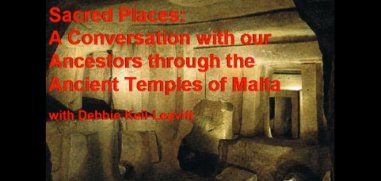
Here are links to A Conversation with our Ancestors through the
Ancient Temples of MALTA
August
10, 2014 - Facilitated by our Featured Speaker Debbie Keil-Leavitt & SSJs Director
Andrea Mikana-Pinkham
Part 1/Introduction: Ancient Sites of Malta: A discussion on the ancient sites of
Malta, their acoustical and astronomical wonders, and the possibilities of what these
treasures may offer.
https://www.youtube.com/watch?v=CcAp-HPNZ-c&feature=youtu.be
Part 2: Maltese Myth and Legend, Climate Change, the Early “Goddess”
Period, and Ggantija.
https://www.youtube.com/watch?v=04uKbHFt8xo&feature=youtu.be
Part 3: Sound and Vibration, Ancient Sites of Malta: The Hypogeum’s Amazing
Acoustical Wonders, an Ancient Healing Center?
https://www.youtube.com/watch?v=591tpDeYAaI&feature=youtu.be
Part 4: Ancient Sites of Malta: The Sky, Our Shared Stars, Travel and Credits
https://www.youtube.com/watch?v=-BVo9vGa2Qg&feature=youtu.be
And here are links to 3 excellent YouTube videos with Debbie Keil-Leavitt on Ice Age Art
and Malta:
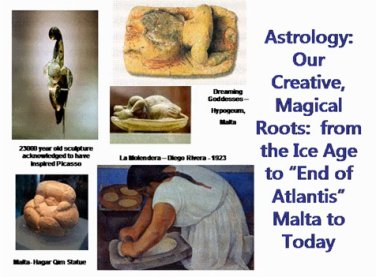
Part
1: https://www.youtube.com/watch?v=tXLpLlUwRUU
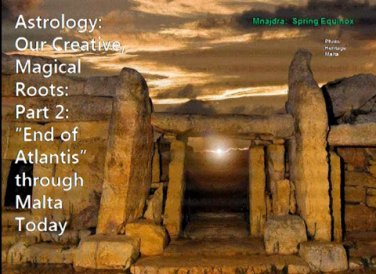
Part 2: https://www.youtube.com/watch?v=Gny2FSDCkds
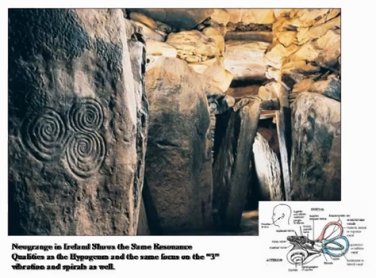
Part 3: https://www.youtube.com/watch?v=38FocLAts48

TOUR ITINERARY
(B = Breakfast, L = Lunch, D = Dinner)
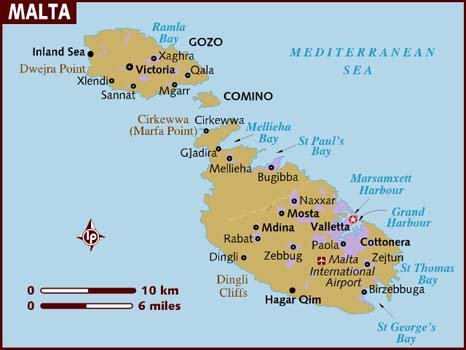
Day 1.
Sunday, November 2. Arrive Malta. Introductory Meeting & Welcome Dinner (D)
Arrive in Malta on your own. Please book your air to Malta - Airport Code MLA. We encourage you to arrive early enough in the day so that
you’ll have a chance to rest before our afternoon and evening activities. If
you’d like to come a day early, we can give you a quote for the extra night or
nights, once you register. After you book your international air, if you’d like for
SSJ to give you a quote for your private transfer to the hotel, please send us this
request. For group participants arriving within an hour of each other, we’ll work
with you to schedule a transfer for several people in order to minimize the expense.
Evening Group Introductory Meeting/ Welcome Dinner.
Overnight Valetta. Phoenicia Hotel.
Day 2. Monday, November 3.
Cart Ruts, National Museum of Archaeology, Free Time (B/L)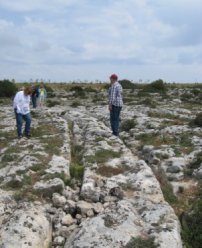
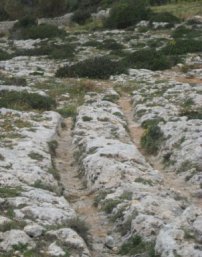 After
breakfast we're off to explore the mysterious ancient “cart ruts” that
have been the subject of debate for hundreds of years as to their origin, form and
function - a most perplexing mystery! Here on the
islands of Malta and Gozo they are the most famous and numerous. Deep ruts, tracks and
grooves left in the limestone in such numbers, variety and confusion leave more questions
than answers. On Malta there are cart ruts going off high cliff tops, while some are
located on the sea floor. At both Clapham Junction and San Gwann
Junction. there are many that intersect each other in total chaos. The Clapham
Junction site was nicknamed that after the complex railway tracks of a London station. How
were they formed? If they're made by humans, who were they and why did they make them?
We'll explore this longtime mystery and see what conclusions we can come to for ourselves. After
breakfast we're off to explore the mysterious ancient “cart ruts” that
have been the subject of debate for hundreds of years as to their origin, form and
function - a most perplexing mystery! Here on the
islands of Malta and Gozo they are the most famous and numerous. Deep ruts, tracks and
grooves left in the limestone in such numbers, variety and confusion leave more questions
than answers. On Malta there are cart ruts going off high cliff tops, while some are
located on the sea floor. At both Clapham Junction and San Gwann
Junction. there are many that intersect each other in total chaos. The Clapham
Junction site was nicknamed that after the complex railway tracks of a London station. How
were they formed? If they're made by humans, who were they and why did they make them?
We'll explore this longtime mystery and see what conclusions we can come to for ourselves.
Afterwards we enjoy a lunch of traditional Maltese cuisine with the group at a local
restaurant.
Then we're off to the National Museum of
Archaeology, a Maltese museum of prehistoric artifacts that is managed by
Heritage Malta. The ground floor of the museum exhibits prehistoric artifacts from the
Maltese islands, from the Ghar Dalam phase (5200 BCE), the earliest appearance of
settlement on the island, up to the Tarxien phase (2500 BCE).
Early Neolithic Period Room (5200–3800 BCE)
The Hal Saflieni Hypogeum: This room exhibits artifacts from the early Neolithic Period,
including decorated pottery from the Ghar Dalam, Grey Skorba, Red Skorba and Zebbug
phases. Of particular importance are the Red Skorba figurines, the earliest local
representations of the human figure and the predecessors of the statues of later temple
periods. The exhibition features a reconstruction of the rock-cut tombs that were a
characteristic of the early Neolithic period in Malta.
Temple Period Rooms (3800–2500 BCE)
These rooms show examples of architecture, human representation and other items that date
from the Mgarr, Ggantija, Saflieni and Tarxien phases of Maltese prehistory. The temples
that were built at this time are considered to be the world’s first free standing
monuments and are listed in the UNESCO World Heritage List.
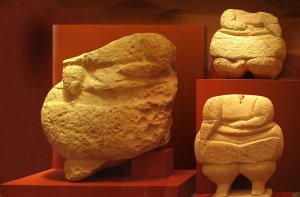 The
museum exhibits numerous corpulent statues representing human bodies
unearthed from temple excavations, along with phallic representations. Are these statues
of the Mother Goddess, Fat Ladies, Deities or Priests? The discovery of temple altars and
corpulent human representations suggests that some type of cult existed on the islands of
Malta and Gozo in prehistory. Given the corpulence of the statues it may be that the cult
was tied to a fertility rite. Fertility at this time must have been very important since,
apart from family growth, it also meant the reproduction of crops and animals. We’ll
explore the theories during our time here in this sacred land. The
museum exhibits numerous corpulent statues representing human bodies
unearthed from temple excavations, along with phallic representations. Are these statues
of the Mother Goddess, Fat Ladies, Deities or Priests? The discovery of temple altars and
corpulent human representations suggests that some type of cult existed on the islands of
Malta and Gozo in prehistory. Given the corpulence of the statues it may be that the cult
was tied to a fertility rite. Fertility at this time must have been very important since,
apart from family growth, it also meant the reproduction of crops and animals. We’ll
explore the theories during our time here in this sacred land.
We return to hotel later afternoon. You have free time.
Dinner is on your own this evening. You can either eat at the hotel, or stroll along the
nearby streets where there are many restaurants.
Overnight Valetta. Phoenicia Hotel.
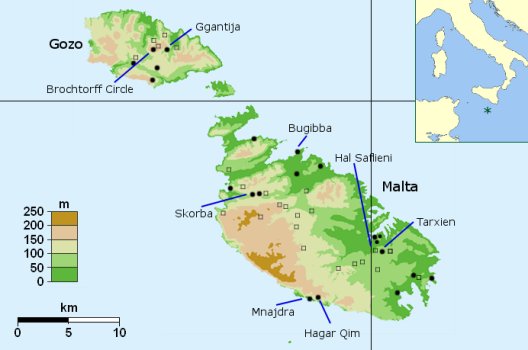
Map of Megalithic Mother
Goddess Sites on Malta and Gozo
Day 3. Tuesday,
November 4. Mgarr: Skorba and Ta Hagrat Temples; Mdina (B/L)
Today we begin our exploration and experiences of the sacred Goddess temples of Malta!
After breakfast we depart by coach to the Village of Mgarr (im-jarr), a
small town in the southeast part of Gozo, a typical rural village situated in an isolated
region, to visit the temples of Ta Hagrat and Skorba.
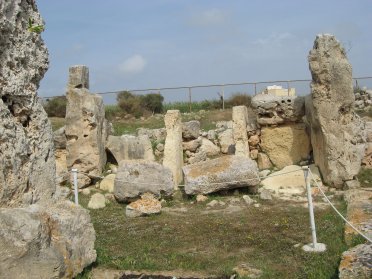
Our first stop is at the Skorba temples, megalithic remains on the
northern edge of Zebbieg which have provided detailed and informative insight into the
earliest periods of Malta's Neolithic culture. The site was only excavated in the early
1960s, rather late in comparison to other megalithic sites, some of which had been studied
since the early 19th century. The site's importance has led to its listing as a UNESCO
World Heritage Site, a listing it shares with six other megalithic temples in
Malta.
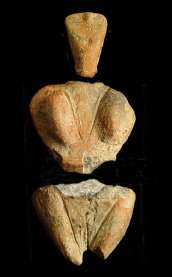 The remains on the site are
a series of megalithic uprights, the lowest course of the temples' foundations, paving
slabs with libation holes in the entrance passage, and the torba or cement-like floor of a
three-apse temple, a shape that is typical of the Ggantija phase. Unfortunately, the
greater part of the first two apses and the whole of the fašade have been razed to ground
level. But the north wall is in a better state of preservation. Originally, the entrance
of the temple opened on a court, but in later additions during the Tarxien phase, the
temple's doorway was closed off, with altars set in the corners formed by the closure.
East of this temple, a second monument was added in the Tarxien phase, with four apses and
a central niche. For a period of roughly twelve centuries before the temples were built, a
village already stood on the site. Its oldest extant structure is the long straight wall
to the west of the temples’ first entrance. Deposits at its base contained material
from the first known human occupation of the island, the Ghar Dalam
phase, including charcoal, which carbon analysis dated to 4850 BCE. The remains on the site are
a series of megalithic uprights, the lowest course of the temples' foundations, paving
slabs with libation holes in the entrance passage, and the torba or cement-like floor of a
three-apse temple, a shape that is typical of the Ggantija phase. Unfortunately, the
greater part of the first two apses and the whole of the fašade have been razed to ground
level. But the north wall is in a better state of preservation. Originally, the entrance
of the temple opened on a court, but in later additions during the Tarxien phase, the
temple's doorway was closed off, with altars set in the corners formed by the closure.
East of this temple, a second monument was added in the Tarxien phase, with four apses and
a central niche. For a period of roughly twelve centuries before the temples were built, a
village already stood on the site. Its oldest extant structure is the long straight wall
to the west of the temples’ first entrance. Deposits at its base contained material
from the first known human occupation of the island, the Ghar Dalam
phase, including charcoal, which carbon analysis dated to 4850 BCE.
We’ll take time for meditation to connect with these ancient
energies.
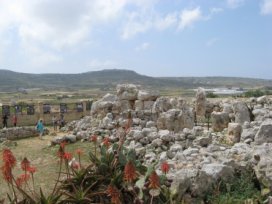 Next we visit the Ta Hagrat
temples in Mgarr, of which the larger temple dates from the Ggantija phase (3600–3200
BCE); the smaller is dated to the Saflieni phase (3300–3000 BCE). Next we visit the Ta Hagrat
temples in Mgarr, of which the larger temple dates from the Ggantija phase (3600–3200
BCE); the smaller is dated to the Saflieni phase (3300–3000 BCE).
Major Temple: The Ggantija phase temple is typically trefoil, with a
concave fašade opening onto a spacious semicircular forecourt. The fašade contains a
monumental doorway in the center and a bench at its base. Two steps lead up to the main
entrance and a corridor flanked by upright megaliths of coralline limestone. Three are
placed on each side and support large hard-stone slabs. The corridor beyond the entrance
is paved with large stone blocks placed with great accuracy. 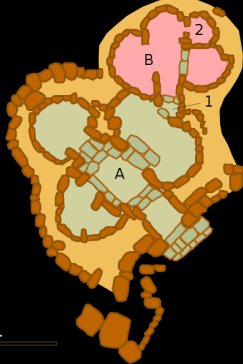
The corridor leads into a central torba court, radiating three semi-circular chambers.
These were partially walled off at some time in the Saflieni phase; pottery shards were
recovered from the internal packing of this wall. The apses are constructed with
roughly-hewn stone walls and have a rock floor. Corbelling visible on the walls of the
apses suggest that the temple was roofed.
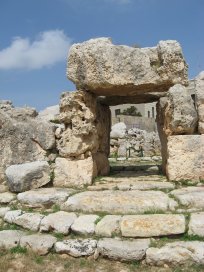
Minor Temple: The Saflieni phase temple rests to the north and is 21 ft.
long, and is entered through the eastern apse of the larger temple. Smaller stones have
been used in its construction and it exhibits irregularities in design considered archaic
or provincial.
Another meditation opportunity will assist us to use our “psychic
archaeology” to tune into the lives of the Mother Goddess people who lived here in
ancient times.
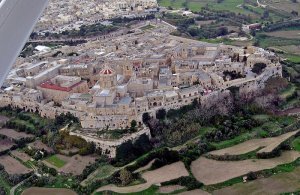 Afterwards we enjoy our group
lunch. And then are off to Mdina, the old capital of Malta. Mdina is a medieval
walled town situated on a hill in the center of the island. Punic remains
uncovered beyond the city’s walls suggest the importance of the general region to
Malta’s Phoenician settlers. Mdina is commonly called the "Silent City" by
natives and visitors. The town is still confined within its walls, and has a population of
just over three hundred, but it is contiguous with the village of Rabat, which takes its
name from the Arabic word for suburb, and has a population of over 11,000. Mdina is
fascinating to visit for its timeless atmosphere as well as its cultural and religious
treasures. Afterwards we enjoy our group
lunch. And then are off to Mdina, the old capital of Malta. Mdina is a medieval
walled town situated on a hill in the center of the island. Punic remains
uncovered beyond the city’s walls suggest the importance of the general region to
Malta’s Phoenician settlers. Mdina is commonly called the "Silent City" by
natives and visitors. The town is still confined within its walls, and has a population of
just over three hundred, but it is contiguous with the village of Rabat, which takes its
name from the Arabic word for suburb, and has a population of over 11,000. Mdina is
fascinating to visit for its timeless atmosphere as well as its cultural and religious
treasures.
The history here goes back more than 4000 years. According to tradition
it was here that in 60 CE that the Apostle St. Paul is said to have lived after being
shipwrecked on the Islands. He supposedly resided inside the grotto known as Fuori le Mura
(outside the city walls) now known as St. Paul’s Grotto in Rabat. The late
17th-century St. Paul's Cathedral in Mdina stands on the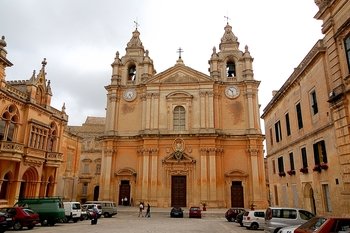 traditional site of the house
of the governor Publius, who received St. Paul when he was shipwrecked on Malta. traditional site of the house
of the governor Publius, who received St. Paul when he was shipwrecked on Malta.
Mdina has had different names and titles depending on its rulers and its role but its
medieval name describes it best – ‘Citta’ Notabile’: the noble
city. It was home then, as now, to Malta’s noble families; some are
descendants of the Norman, Sicilian and Spanish overlords who made Mdina their home from
the 12th century onwards. Impressive palaces line its narrow, shady streets. Mdina is one
of Europe’s finest examples of an ancient walled city and extraordinary in its mix of
medieval and Baroque architecture. During our tour we will stop at the bastions of Mdina
to admire the extensive views of Malta from one of the highest points on the island.
We return to hotel later afternoon. You have free time.
Dinner is on your own this evening.
Overnight Valetta. Phoenicia Hotel.
Day 4. Wednesday, November 5. Hypogeum (Private
Entrance), Tarxien Temples (B/D)
This morning we have our private entrance into the Hypogeum, followed by a visit to the
Tarxien Temples. 
The Hypogeum of Hal Saflieni, or
underground cavity carved from solid rock, is a unique monument and superb example of
architecture in the negative. Excavation has yielded a wealth of archaeological material
including pottery, human bones, personal ornaments such as beads and amulets, little
carved animals and larger figurines.
When discovered it contained the bodies of over 7,000 people. Three
stories deep, it contains rock-cut features such as a 'speaking chamber', trilithons,
lintelled-doorways, a large cistern and a 'holy of holies' surrounded by 'embryonic'
chambers. The Hypogeum is one of the greatest remaining structures from prehistory.
Its pristine condition allows us to see the past through the eyes of our ancestors.
  
The purpose of the Hypogeum is one of the most
highly debated in circles of megalithic architecture. This amazing and very
unique underground space offers us a rare glimpse at the prehistoric synthesis of
funerary, solar-worship and shamanic traditions. Perhaps the central chamber's several
small rounded cubicles carved into the walls were originally intended for 'living' people
as part of a ritual, in which they would have had to lie inside in a fetal position.
Traces of ergot have been found in the chamber called the 'cistern'; one of the physical
effects of ergot is to constrict bodily muscles, resulting in a forced fetal position. In
these small cubicles, echoes from the 'speaking' chamber reverberate into a rhythm that is
similar to the human heartbeat.
The entrance to the Hypogeum is through an unsuspecting doorway
in an unsuspecting street. It was first discovered in 1902, when builders broke
through whilst building foundations for a house. At first, the hole was covered over and
the event was kept quiet but word of the discovery soon got out and the museum authorities
moved in to protect it. Although underground, the Hypogeum was built near the top of a
natural hill overlooking the Marsa. The nearby Hal Tarxien, temple complex was built
higher still on the same face of the hill.
Although most of the Hypogeum is underground, the entrance to it was
built with megaliths, placed in what was presumably the natural entrance of the original
cave. The original entrance consisted of a large square opening in its center (a porthole
slab). This slab was later smashed and disposed of to make way for the new housing estate.
The first excavations in 1902 were performed by Fr. Magri, S.J. but
unfortunately shortly after its commencement, he left the island to take a missionary post
abroad where he died, leaving no records of his observations. Following this, the work was
passed on to Prof. Themi Zammit, who worked on it for the next five years. The 1990-1992
excavations suggested that there may have once been a monumental structure built directly
on top.
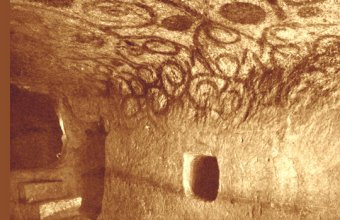 The speaking
chamber has a hole known as the oracle hole in the wall carved
with a rounded interior surface. A design was painted in red-ochre onto the ceiling of the
chamber; it starts off on one side with a honeycomb design and transforms into a
collection of 'floral' spirals on the other. It's speculated that the oracle hole was part
of a ceremonial process. Words spoken into it make an echo which reverberates throughout
the hypogeum. The speaking
chamber has a hole known as the oracle hole in the wall carved
with a rounded interior surface. A design was painted in red-ochre onto the ceiling of the
chamber; it starts off on one side with a honeycomb design and transforms into a
collection of 'floral' spirals on the other. It's speculated that the oracle hole was part
of a ceremonial process. Words spoken into it make an echo which reverberates throughout
the hypogeum.
The results of recent scientific study suggests that
the 6,000 year-old hypogeum could have been specifically designed to conduct and
manipulate sound to produce certain effects on the human brain. In this way,
people in the hypogeum experienced mood changes while listening to chanting.
Some scientists believe that certain sound vibration frequencies created when sound is
emitted within its walls are actually altering human brain functions of
those within earshot. According to a laboratory study, exposure to a tone within this
frequency, particularly at 110-111 hz seems to create a shift of
brain function, "turning on" an area of the brain that bio-behavioral
scientists believe relates to mood, empathy and social behavior.
We’ll have a sound meditation here to support altering our
consciousness to higher frequencies. 
The hypogeum includes replicas of features from megalithic structures above ground on
Malta. It is possible to see both trilithons and 'doorways' in the same style as those
found in the numerous temples on the islands. It was also the place where the famous
terracotta figure called the Sleeping Lady was found in a cistern
containing numerous offerings. Two of these clay figurines were found in the Hypogeum. One
(left) in a sleeping position, and the other of similar design, but with the woman lying
face down. They were both found in the main chamber.
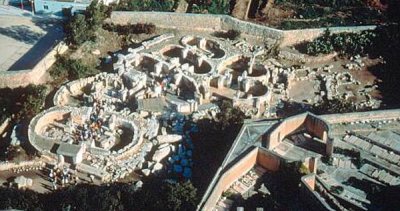 Then
we're off to the Tarxien (tar-she-en) Temples, which date from 3600-2500
BCE and are the most complex of all temple sites in Malta. The
temples are renowned for the detail of their carvings, which include domestic
animals carved in Then
we're off to the Tarxien (tar-she-en) Temples, which date from 3600-2500
BCE and are the most complex of all temple sites in Malta. The
temples are renowned for the detail of their carvings, which include domestic
animals carved in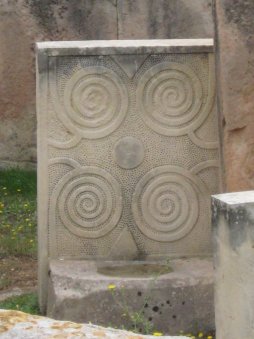 relief, altars, and screens decorated with spiral
designs and other patterns. The spiral is the most common design in megalithic
art on Malta, and indeed around the world. Believed by some to represent eternity, the
design is expressed in a wide variety of forms across the islands and clearly had a
significant meaning for the ancient Maltese peoples. Of particular note is a chamber set
into the thickness of the wall between the South and Central temples, which is famous for
its relief of two bulls and a sow. The site seems to have been used
extensively for rituals, which probably involved animal sacrifice. relief, altars, and screens decorated with spiral
designs and other patterns. The spiral is the most common design in megalithic
art on Malta, and indeed around the world. Believed by some to represent eternity, the
design is expressed in a wide variety of forms across the islands and clearly had a
significant meaning for the ancient Maltese peoples. Of particular note is a chamber set
into the thickness of the wall between the South and Central temples, which is famous for
its relief of two bulls and a sow. The site seems to have been used
extensively for rituals, which probably involved animal sacrifice.
In the Bronze Age (2400-1500 BCE), Tarxien was reused as a cremation cemetery.
The site lay hidden for centuries until its discovery in 1914, when farmers struck large
stone blocks while ploughing a field. Sir Temistocles Zammit, Malta’s first director
of museums, excavated the site in 1915-17.
 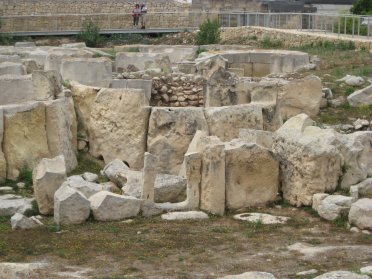 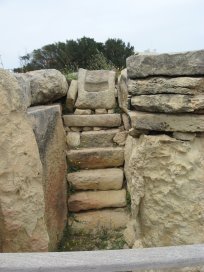 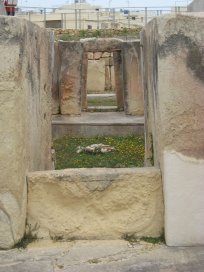
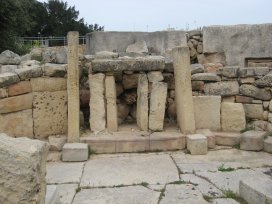 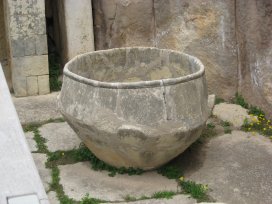
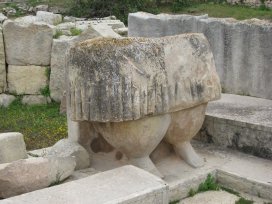 The Tarxien
temple complex consists of four temples connected by a square court. The
temples each have separate entrances. Uniquely, the central temple consists of six apses.
This is the only known example of such a layout and it represents a final phase in the
long evolution of Maltese temple architecture. A narrow staircase connects the central
temple to the east temple. The Tarxien
temple complex consists of four temples connected by a square court. The
temples each have separate entrances. Uniquely, the central temple consists of six apses.
This is the only known example of such a layout and it represents a final phase in the
long evolution of Maltese temple architecture. A narrow staircase connects the central
temple to the east temple.
Fertility goddess figures (now in the national museum in Valetta)
discovered in the ruins indicate that the temples were dedicated to the Earth
Mother/the Mother Goddess, as were many Maltese temples. The most famous of these
figures is a sculpture of large hips with feet, dubbed the "Fat Lady."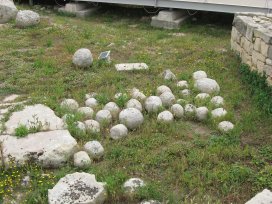
Spherical stones found at the site have provided a valuable clue as to
how the great stones of Malta's megalithic temples may have been moved into place; some
researchers believe they were rolled on the stones while being towed with ropes.
We’ll discuss this and other theories about the ancient megalithic building
techniques.
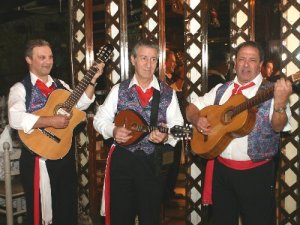 Afterwards we return to the
hotel. You have free time for lunch on your own. And time to explore more of the area! Afterwards we return to the
hotel. You have free time for lunch on your own. And time to explore more of the area!
Tonight we have our group dinner at the Ta’ Marija Maltese restaurant
located in the village of Mosta for a lively and enjoyable evening of dinner and
entertainment.
Overnight Valetta. Phoenicia Hotel.
Day 5. Thursday, November 6. FULL MOON! Hagar Qim / Mnajdra and Blue Grotto (B/L)
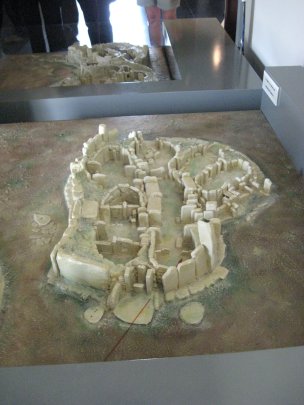 After breakfast we head to the
temple of Hagar Qim (ha-jah-een), Located on a hilltop overlooking the
sea and the islet of Filfla, it’s the best-preserved of several
ancient limestone temples in Malta. It dates from the Ggantija phase - which is about 3600
to 3200 BCE. Unlike most other Maltese temples, it is a single temple
rather than a complex of two or three. Other temple ruins stand a few feet away from the
main temple and the forecourt and facade follow the After breakfast we head to the
temple of Hagar Qim (ha-jah-een), Located on a hilltop overlooking the
sea and the islet of Filfla, it’s the best-preserved of several
ancient limestone temples in Malta. It dates from the Ggantija phase - which is about 3600
to 3200 BCE. Unlike most other Maltese temples, it is a single temple
rather than a complex of two or three. Other temple ruins stand a few feet away from the
main temple and the forecourt and facade follow the 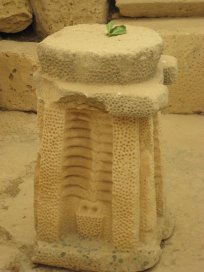 pattern typical of temples across the Islands. Particularly noteworthy are
the larger standing stones at the corners, which are notched to take the
second of the horizontal courses above, which are traditional megalithic building
techniques. pattern typical of temples across the Islands. Particularly noteworthy are
the larger standing stones at the corners, which are notched to take the
second of the horizontal courses above, which are traditional megalithic building
techniques.
A stone decorated with spiral designs and a free-standing altar decorated
on all sides were found here. The right apse has an interesting inner enclosure made of
low stone slabs. The left apse has three high table altars and a low-standing pillar at
the end. Three steps up from the left apse lead to an additional chamber. In the outer
enclosing wall, the first upright stone behind the right-hand corner of the fašade is one
of the largest of any temple, at about 21 ft. long and close to 20 tons in weight.
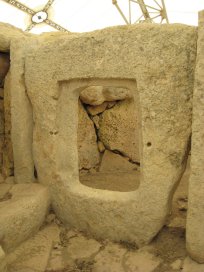 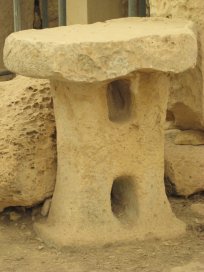
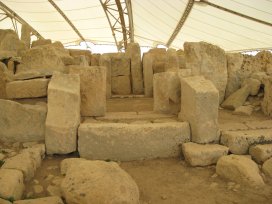 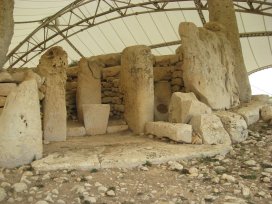 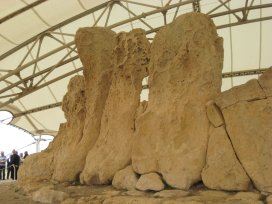
 Other
related ruins have been uncovered near the main temple, and two Mother Goddess
statues discovered here are now in display in the national museum in Valetta. Other
related ruins have been uncovered near the main temple, and two Mother Goddess
statues discovered here are now in display in the national museum in Valetta.
Take some time for a meditation to
connect once again with the Mother Goddess energies.
Afterwards we’ll enjoy lunch on your own with the
group at the Hagar Qim Restaurant.
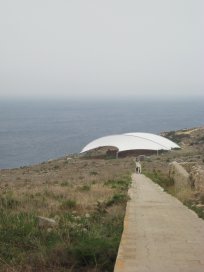
Then we head down the hill to Mnajdra (mna-ee-dra),
a complex site consisting of three conjoined Neolithic temples
overlooking an oval forecourt. The first and oldest temple dates back to 3600-3200 BCE,
while the most impressive of the temples is the third, constructed between 3150-2500
BCE. This temple is perhaps the finest surviving on the Islands.
The masonry here shows intricate knowledge of building techniques and excellent
workmanship. And though Mnajdra is less than a mile downhill from the Hagar Qim temple
complex, the two complexes seem to have built at different times, and their relationship
is not known.
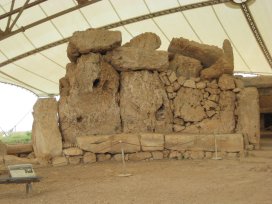 The first and oldest temple
(northern/eastern) is a simple three-apsed structure dating from c.3600-3200 BCE,
not long after Ggantija was built. The small walls have been reconstructed but the small
uprights, with their pitted decoration, are original. The first and oldest temple
(northern/eastern) is a simple three-apsed structure dating from c.3600-3200 BCE,
not long after Ggantija was built. The small walls have been reconstructed but the small
uprights, with their pitted decoration, are original.
The middle temple is the largest and
was the last to be built, closer to 2000 BCE. It was inserted between the other two and
set at a higher level, and is unusual in having a great 9 ft. high porthole slab (now
broken) as its main entrance, with a second doorway beside it. To the left of the passage
leading to the inner apses is an engraving of a temple facade.
The most impressive of the Mnajdra temples is the lower (southern/western) temple,
with a largely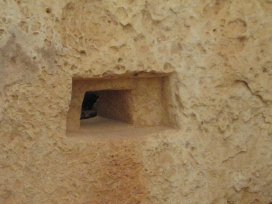 intact fašade
and bench constructed sometime between 3150 and 2500 BCE. Its corbelled walls indicated
the temple was roofed (as at Ggantija), and the stone slabs are decorated with intriguing
spiral carvings and dotted patterns. The porthole niche to the left is especially
impressive, framed in a trilithon and two strangely tapered megaliths on either side. intact fašade
and bench constructed sometime between 3150 and 2500 BCE. Its corbelled walls indicated
the temple was roofed (as at Ggantija), and the stone slabs are decorated with intriguing
spiral carvings and dotted patterns. The porthole niche to the left is especially
impressive, framed in a trilithon and two strangely tapered megaliths on either side.
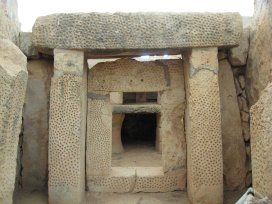
In the right-hand apse of the lower temple is a porthole doorway at the
top of a flight of steps giving access to an intramural chamber. An oracle hole opens from
that chamber and another oracle hole in a recess communicates with the back and outside of
the temple. Within the first side chamber is an altar on a double-hourglass shaped pillar.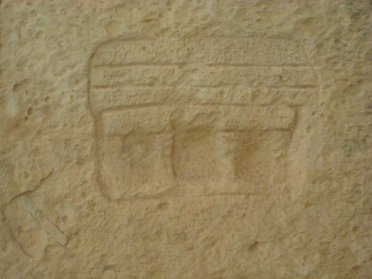
The lower temple is astronomically aligned. On the equinoxes the rays of
the sun pass directly through the temple’s main doorway and light up the main axis.
At the summer solstice, the sun lights up the edge of a megalith to the left of the
doorway, connecting the first pair of chambers to the inner chambers. At the winter
solstice, the same effect can be seen on the corresponding megalith on the right hand
side.
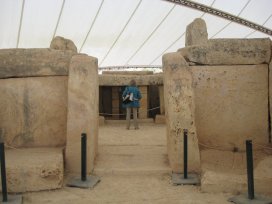
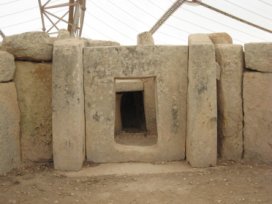
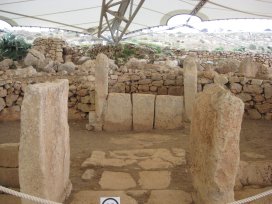
We'll have time for meditation to
assist moving us into higher states of awareness. 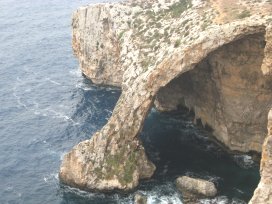
After our temple visits we’ll enjoy lunch on your own with the group at the Hagar
Qim Restaurant.
We then head to the south of the island to the area known as Wied Iz-Zurrieq or more
commonly known as the Blue Grotto. Weather permitting, we’ll have a
short boat trip to the Grotto. This natural picturesque grotto and its neighboring system
of caverns mirrors the brilliant phosphorescent colors of the underwater flora. From Wied
iz-Zurrieq lookout point we will also see the small island of Filfla, which is uninhabited
except for a unique species of lizards. .
We return to hotel later afternoon. You have free time.
Dinner is on your own this evening.
Tonight is the "goddess wisdom" FULL MOON at
the "witching hour" - 11:22PM. After our powerful visits to the Hypogeum and
Tarxien, Hagar Qim and Mnajdra and the night before our visit to the amazing goddess
island of Gozo with the extremely ancient Ggantija Temple
tomorrow. The Underworld Goddess Sedna and Venus/Inanna
are working together with this Moon in the skies and our Earth Goddess sites to speak to
the world about powerful feminine energies for healing and peace. You won't want to miss
it if you are a voice for building a peaceful, rich future for ourselves and our sons and
daughters and their sons and daughters. IMPORTANT! For
those who will be on this spiritual journey, Debbie will read these powerful events in
your astrological chart. Once you register, SSJ will ask you to provide your birth data to
Debbie so that she can do so.
Overnight Valetta. Phoenicia Hotel.
Day 6. Friday, November 7. Ggantija, Azure Window, The
Citadel (B/L/D)
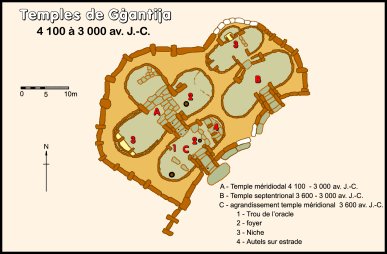 We’re off for a
full day on Gozo to visit more Goddess temples! Our first stop is at the Ggantija
(gii-gan-tii-ya) Prehistoric Temples in Xaghra (sha-ra). The Ggantija temples are the
earliest of a series of megalithic temples here. The ancient builders erected the two
Ggantija temples during the Neolithic Age (c. 3600-2500 BCE), which makes
these temples more than 5500 years old and some of the world's oldest
humanmade religious structures. Together with other similar structures, these have been
designated a UNESCO World Heritage Site. We’re off for a
full day on Gozo to visit more Goddess temples! Our first stop is at the Ggantija
(gii-gan-tii-ya) Prehistoric Temples in Xaghra (sha-ra). The Ggantija temples are the
earliest of a series of megalithic temples here. The ancient builders erected the two
Ggantija temples during the Neolithic Age (c. 3600-2500 BCE), which makes
these temples more than 5500 years old and some of the world's oldest
humanmade religious structures. Together with other similar structures, these have been
designated a UNESCO World Heritage Site.
According to local Gozitan folklore, giants
built these temples and used them as places of worship. Evidence indicates there was an oracle
here, as at the much-later Temple of Apollo at Delphi. A priestess prophesied while in a
trance, possessed by the spirit of the goddess. Ggantija also seems to have been a place
to pray for healing. In ancient times, the temples dedicated to the
Mother Goddess at Ggantija drew pilgrims from across the island and even from North Africa
and Sicily.
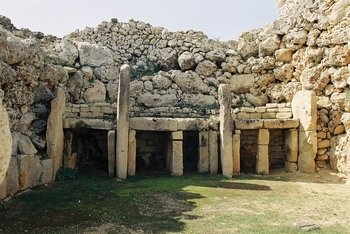
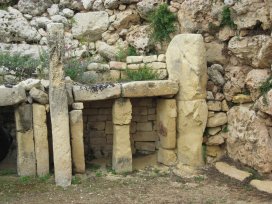 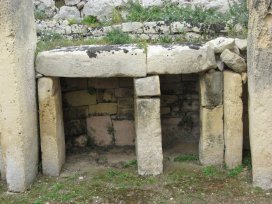
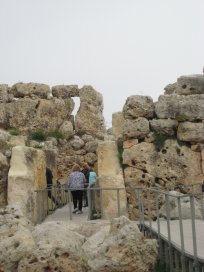
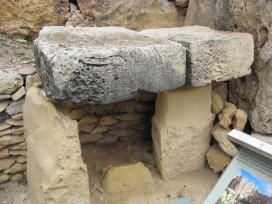
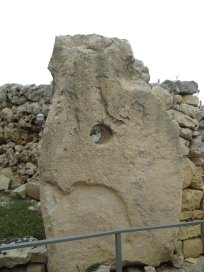
During our visit take time for meditation
to connect to the ancient Mother Goddess energies. 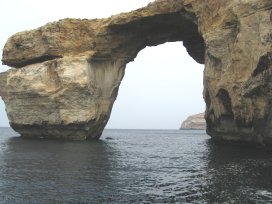
From here we will proceed to Dwejra to see the Azure Window, Fungus Rock
and the Inland Sea. The Azure Window at the end of the cliff, is a giant doorway, through
which one can admire the blue expanse beyond the cliff. It must be one of the most
photographed vistas of the Islands, and is particularly spectacular during the winter,
when waves crash high inside the arch. The sea around is very deep and of a dark blue hue,
thus giving it the name the Azure Window. The rocks in this area are encrusted with
fossilized crustaceans, evidence that most of the island was once covered by water. In
front of the Azure Window is the Blue Hole, and The Chimney, two of the most popular dive
sites in Gozo.
Afterwards we'll have lunch with the group at a lovely restaurant in the city of Victoria.
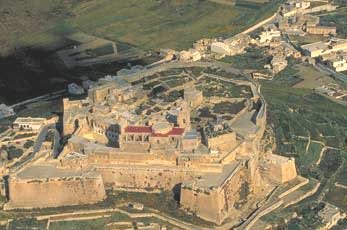 Then we visit the medieval
part of the city of Victoria – The Citadel, an
historic fortified city or castle. It's on Malta's tentative list of future World Heritage
Sites by UNESCO, who describe it as a small fortified town. The area is known to have been
first fortified during the Bronze Age c. 1500 BCE, was later developed by the Phoenicians
and continued development until, by Roman times, it had become a complex Acropolis. Up
until the 18th Century it was the only fortified refuge against attack for the inhabitants
of the island. The northern side of the Citadel dates back to the period of the Crown of
Aragon, while the southern flank, overlooking Victoria, was re-constructed between 1599
and 1603 by the Knights of St. John. The massive defensive stone walls of the
fortifications which rise above the town and were built by the Knights to protect the
village communities from foraging corsairs attempting to take slaves and threatening
invasion of Moslem forces fighting Christendom. In July 1551 a small Turkish force under
Dragut attacked the Citadel, which succumbed with little resistance. Those taking refuge
within its walls were taken as slaves and the castle reduced to ruins. Within its walls
lies a fine 17th century baroque Cathedral designed by Lorenzo GafÓ, the
Maltese architect who also built the Cathedral of Mdina. Some researchers say that it lies
on the site where a Roman temple dedicated to Juno once stood. It is most
famous for the remarkable trompe l'oeil painting on its ceiling, which depicts the
interior of a dome that was never built. Then we visit the medieval
part of the city of Victoria – The Citadel, an
historic fortified city or castle. It's on Malta's tentative list of future World Heritage
Sites by UNESCO, who describe it as a small fortified town. The area is known to have been
first fortified during the Bronze Age c. 1500 BCE, was later developed by the Phoenicians
and continued development until, by Roman times, it had become a complex Acropolis. Up
until the 18th Century it was the only fortified refuge against attack for the inhabitants
of the island. The northern side of the Citadel dates back to the period of the Crown of
Aragon, while the southern flank, overlooking Victoria, was re-constructed between 1599
and 1603 by the Knights of St. John. The massive defensive stone walls of the
fortifications which rise above the town and were built by the Knights to protect the
village communities from foraging corsairs attempting to take slaves and threatening
invasion of Moslem forces fighting Christendom. In July 1551 a small Turkish force under
Dragut attacked the Citadel, which succumbed with little resistance. Those taking refuge
within its walls were taken as slaves and the castle reduced to ruins. Within its walls
lies a fine 17th century baroque Cathedral designed by Lorenzo GafÓ, the
Maltese architect who also built the Cathedral of Mdina. Some researchers say that it lies
on the site where a Roman temple dedicated to Juno once stood. It is most
famous for the remarkable trompe l'oeil painting on its ceiling, which depicts the
interior of a dome that was never built.
In the later afternoon we return to Mgarr Harbor and board the ferryboat to return to
Malta, arriving at our hotel later afternoon.
Tonight is our Farewell Dinner at the hotel.
Overnight Valetta. Phoenicia Hotel.
Day 7. Saturday, November 8. Depart Malta (B)
Tour ends after breakfast.
Transfer on your own to the airport, or request a quote for a private transfer from
SSJ after you register. For group participants departing within an hour of each other,
we’ll work with you to schedule a transfer for several people in order to minimize
the expense.
This itinerary is subject to change due to
conditions beyond our control.
Post-Tour Extension on GOZO for Writer’s
Retreat
November 7- 11, 2014
Our Featured Speaker Debbie
Keil-Leavitt will be hosting a small group on Gozo for other writers after the main tour.
NOTE: This group is open to a maximum of 5 participants.
Day 6. Friday,
November 7. Ggantija, Azure Window, The Citadel (B/L)
After your full day visit to Gozo with the group, including lunch, when they return to
Malta, you will check into your accommodations.
Free time. Dinner on your own.
Overnight Gozo. Zerniq Misrah Simar Apartments.
Day 7. Saturday, November 8. Gozo
Free time for Writer’s Group
All meals on your own.
Overnight Gozo. Zerniq Misrah
Simar Apartments.
Day 8. Sunday, November 9. Gozo
Free time for Writer’s Group
All meals on your own.
Overnight Gozo. Zerniq Misrah
Simar Apartments.
Day 9. Monday, November 10. Return to Malta (D)
This morning you transfer to Mgarr Harbor and board the ferryboat to return to Malta. Upon
arrival transfer to your hotel.
You have free time to rest and explore on your own before dinner with the group at the
hotel.
Overnight Valetta. Phoenicia Hotel.
Day 10. Tuesday, November 11. Depart Malta (B)
Tour ends after breakfast.
Transfer on your own to the airport, or request a quote for a private transfer from SSJ
after you register. For group participants departing within an hour of each other,
we’ll work with you to schedule a transfer for several people in order to minimize
the expense.
This itinerary is subject to change due to
conditions beyond our control.

TOUR INCLUSIONS
MAIN TOUR INCLUDES:
- 6 night’s accommodation at the Phoenicia Hotel, including taxes
- Daily Breakfast, 4 Lunches, 3 Dinners
- Air-conditioned motor coach
- All entrance fees to sites listed in itinerary
- All fees related to visiting special sites which are open only by appointment
- Roundtrip ferry tickets to Gozo
- 24 hour emergency assistance by ground operator support staff
- Pre-Paid Gratuities
SPECIAL HIGHLIGHTS:
- Travel in a smaller group with other like-minded spiritual seekers
- Tour Hostess/Featured Speaker/Meditation Facilitator: Debbie Keil-Leavitt
- Excellent English-speaking Tour Guide
- Private entrances for our group at the Hypogeum
NOT INCLUDED:
- Round-trip International Air to Malta (MLA)
- Cost to obtain valid passport
- Meals not included in the itinerary; drinks at meals
- Any items of a personal nature such as laundry, drinks, internet service, telephone
calls. Any item that is not specifically detailed in the itinerary
Post-Tour Extension to GOZO INCLUDES:
- 3 night’s accommodation at the Zerniq Misrah Simar
Apartments, including taxes
- 2 Breakfasts, 1 Lunch, 1 Dinner
- Roundtrip ferry tickets to Gozo
- 24 hour emergency assistance by ground operator support staff
NOT INCLUDED:
- Cleaning Fee
- Security Deposit
- Meals not included in the itinerary; drinks at meals
- Any items of a personal nature such as laundry, drinks, internet service, telephone
calls. Any item that is not specifically detailed in the itinerary

TOUR PRICING
(For a group of 14 participants)
This Sacred Sites Journey
to MALTA is LAND ONLY. You are responsible to book your international flights as per
instructions in the tour itinerary above.
 DISCOUNT!
Make ALL of your payments by check or money order and receive a 5% discount!
This discount is INCLUDED in the prices below listed for this payment option.
DISCOUNT!
Make ALL of your payments by check or money order and receive a 5% discount!
This discount is INCLUDED in the prices below listed for this payment option.
MAIN TOUR - November
2 - 8, 2014
Per Person, double occupancy, land only:
$2,159.00 for payments via check or money order
$2,273.00 for payments via credit card
Single Room Supplement:
To Be Posted Soon - for payments via check or money order
To Be Posted Soon - for payments via credit card
ROOMMATES: Would you like to meet and make a new friend on your journey? If you're not
traveling on the journey with anyone you know, and would like for SSJ to try to match you
up with a suitable roommate, we'll be happy to try to do so.
Per our Terms and Conditions, we will hold the registration for the trip open until 30
days before the departure date (or later if possible) in order to try to match you with
someone. If by that date we have not been able to do so, and there is no one to share your
room, you will be responsible to pay for the single supplement. If you would like to be
matched with a roommate, please register early.
Post-Tour Extension to GOZO - November 7 - 11, 2014
Per Person, double occupancy, land only:
$225.00 for payments via check or money order
$237.00 for payments via credit card
PLUS...Additional Fees to be Paid on Arrival at Gozo Apartment. These will be split by the
number of people in the group.
Cleaning Fee: € 35.00
Security Deposit: € 300.00 (Refundable upon departure dependent on the condition of
the apartment.)
NOTE: These fees are to be paid in Euros.

TOUR REGISTRATION
IMPORTANT!
This Sacred Sites Journey to MALTA is being rescheduled to March 22 -
28, 2015.
The itinerary below will be updated soon.
We're working hard to keep the pricing the same as posted for the November 2014 departure.
NOTE: To open
the pdf file, you must have Adobe Acrobat Reader installed on your computer.
To download a FREE copy, click on this link:
http://download.cnet.com/Adobe-Reader-X/3000-10743_4-10000062.html
Questions? Email Andrea Mikana-Pinkham
at info@SacredSitesJourneys.com
Or call our office at 888
501-3853 (Toll free in the US) or 928 284-2384

If you'd like to receive our Monthly Sacred Sites
Journeys E-Newsletters, please Sign Up Here!
Newsletters are sent out about once a month.
Occasionally you may also receive an e-news bulletin about a specific journey or event.
New Subscribers will receive a Travel
Discount Coupon that you can use on one journey per year.
We will not sell or share
your information with any other company or individuals.
You can easily un-subscribe at any time.

We invite you to join our
Sacred Sites Journeys group on Facebook
http://www.facebook.com/groups/SacredSitesJourneys/

NOTE: All photos and text on this webpage are the Copyright of Sacred Sites Journeys/
Heartlight Fellowship.
Sacred Sites Journeys is NOT affiliated
with any other sacred travel company.
Other sacred travel companies offering
spiritual pilgrimages similar to ours
are using our text and photos. We did not give them permission to do so.
We believe that karma is very efficient, and that those who are not in integrity
will swiftly reap the negative benefits of such actions.
Back
to top |











 After
breakfast we're off to explore the mysterious ancient “cart ruts” that
have been the subject of debate for hundreds of years as to their origin, form and
function - a most perplexing mystery! Here on the
islands of Malta and Gozo they are the most famous and numerous. Deep ruts, tracks and
grooves left in the limestone in such numbers, variety and confusion leave more questions
than answers. On Malta there are cart ruts going off high cliff tops, while some are
located on the sea floor. At both Clapham Junction and San Gwann
Junction. there are many that intersect each other in total chaos. The Clapham
Junction site was nicknamed that after the complex railway tracks of a London station. How
were they formed? If they're made by humans, who were they and why did they make them?
We'll explore this longtime mystery and see what conclusions we can come to for ourselves.
After
breakfast we're off to explore the mysterious ancient “cart ruts” that
have been the subject of debate for hundreds of years as to their origin, form and
function - a most perplexing mystery! Here on the
islands of Malta and Gozo they are the most famous and numerous. Deep ruts, tracks and
grooves left in the limestone in such numbers, variety and confusion leave more questions
than answers. On Malta there are cart ruts going off high cliff tops, while some are
located on the sea floor. At both Clapham Junction and San Gwann
Junction. there are many that intersect each other in total chaos. The Clapham
Junction site was nicknamed that after the complex railway tracks of a London station. How
were they formed? If they're made by humans, who were they and why did they make them?
We'll explore this longtime mystery and see what conclusions we can come to for ourselves.
 The
museum exhibits numerous corpulent statues representing human bodies
unearthed from temple excavations, along with phallic representations. Are these statues
of the Mother Goddess, Fat Ladies, Deities or Priests? The discovery of temple altars and
corpulent human representations suggests that some type of cult existed on the islands of
Malta and Gozo in prehistory. Given the corpulence of the statues it may be that the cult
was tied to a fertility rite. Fertility at this time must have been very important since,
apart from family growth, it also meant the reproduction of crops and animals. We’ll
explore the theories during our time here in this sacred land.
The
museum exhibits numerous corpulent statues representing human bodies
unearthed from temple excavations, along with phallic representations. Are these statues
of the Mother Goddess, Fat Ladies, Deities or Priests? The discovery of temple altars and
corpulent human representations suggests that some type of cult existed on the islands of
Malta and Gozo in prehistory. Given the corpulence of the statues it may be that the cult
was tied to a fertility rite. Fertility at this time must have been very important since,
apart from family growth, it also meant the reproduction of crops and animals. We’ll
explore the theories during our time here in this sacred land.

 The remains on the site are
a series of megalithic uprights, the lowest course of the temples' foundations, paving
slabs with libation holes in the entrance passage, and the torba or cement-like floor of a
three-apse temple, a shape that is typical of the Ggantija phase. Unfortunately, the
greater part of the first two apses and the whole of the fašade have been razed to ground
level. But the north wall is in a better state of preservation. Originally, the entrance
of the temple opened on a court, but in later additions during the Tarxien phase, the
temple's doorway was closed off, with altars set in the corners formed by the closure.
East of this temple, a second monument was added in the Tarxien phase, with four apses and
a central niche. For a period of roughly twelve centuries before the temples were built, a
village already stood on the site. Its oldest extant structure is the long straight wall
to the west of the temples’ first entrance. Deposits at its base contained material
from the first known human occupation of the island, the Ghar Dalam
phase, including charcoal, which carbon analysis dated to 4850 BCE.
The remains on the site are
a series of megalithic uprights, the lowest course of the temples' foundations, paving
slabs with libation holes in the entrance passage, and the torba or cement-like floor of a
three-apse temple, a shape that is typical of the Ggantija phase. Unfortunately, the
greater part of the first two apses and the whole of the fašade have been razed to ground
level. But the north wall is in a better state of preservation. Originally, the entrance
of the temple opened on a court, but in later additions during the Tarxien phase, the
temple's doorway was closed off, with altars set in the corners formed by the closure.
East of this temple, a second monument was added in the Tarxien phase, with four apses and
a central niche. For a period of roughly twelve centuries before the temples were built, a
village already stood on the site. Its oldest extant structure is the long straight wall
to the west of the temples’ first entrance. Deposits at its base contained material
from the first known human occupation of the island, the Ghar Dalam
phase, including charcoal, which carbon analysis dated to 4850 BCE. Next we visit the Ta Hagrat
temples in Mgarr, of which the larger temple dates from the Ggantija phase (3600–3200
BCE); the smaller is dated to the Saflieni phase (3300–3000 BCE).
Next we visit the Ta Hagrat
temples in Mgarr, of which the larger temple dates from the Ggantija phase (3600–3200
BCE); the smaller is dated to the Saflieni phase (3300–3000 BCE).

 Afterwards we enjoy our group
lunch. And then are off to Mdina, the old capital of Malta. Mdina is a medieval
walled town situated on a hill in the center of the island. Punic remains
uncovered beyond the city’s walls suggest the importance of the general region to
Malta’s Phoenician settlers. Mdina is commonly called the "Silent City" by
natives and visitors. The town is still confined within its walls, and has a population of
just over three hundred, but it is contiguous with the village of Rabat, which takes its
name from the Arabic word for suburb, and has a population of over 11,000. Mdina is
fascinating to visit for its timeless atmosphere as well as its cultural and religious
treasures.
Afterwards we enjoy our group
lunch. And then are off to Mdina, the old capital of Malta. Mdina is a medieval
walled town situated on a hill in the center of the island. Punic remains
uncovered beyond the city’s walls suggest the importance of the general region to
Malta’s Phoenician settlers. Mdina is commonly called the "Silent City" by
natives and visitors. The town is still confined within its walls, and has a population of
just over three hundred, but it is contiguous with the village of Rabat, which takes its
name from the Arabic word for suburb, and has a population of over 11,000. Mdina is
fascinating to visit for its timeless atmosphere as well as its cultural and religious
treasures. traditional site of the house
of the governor Publius, who received St. Paul when he was shipwrecked on Malta.
traditional site of the house
of the governor Publius, who received St. Paul when he was shipwrecked on Malta.


 The speaking
chamber has a hole known as the oracle hole in the wall carved
with a rounded interior surface. A design was painted in red-ochre onto the ceiling of the
chamber; it starts off on one side with a honeycomb design and transforms into a
collection of 'floral' spirals on the other. It's speculated that the oracle hole was part
of a ceremonial process. Words spoken into it make an echo which reverberates throughout
the hypogeum.
The speaking
chamber has a hole known as the oracle hole in the wall carved
with a rounded interior surface. A design was painted in red-ochre onto the ceiling of the
chamber; it starts off on one side with a honeycomb design and transforms into a
collection of 'floral' spirals on the other. It's speculated that the oracle hole was part
of a ceremonial process. Words spoken into it make an echo which reverberates throughout
the hypogeum.  Then
we're off to the Tarxien (tar-she-en) Temples, which date from 3600-2500
BCE and are the most complex of all temple sites in Malta. The
temples are renowned for the detail of their carvings, which include domestic
animals carved in
Then
we're off to the Tarxien (tar-she-en) Temples, which date from 3600-2500
BCE and are the most complex of all temple sites in Malta. The
temples are renowned for the detail of their carvings, which include domestic
animals carved in relief, altars, and screens decorated with spiral
designs and other patterns. The spiral is the most common design in megalithic
art on Malta, and indeed around the world. Believed by some to represent eternity, the
design is expressed in a wide variety of forms across the islands and clearly had a
significant meaning for the ancient Maltese peoples. Of particular note is a chamber set
into the thickness of the wall between the South and Central temples, which is famous for
its relief of two bulls and a sow. The site seems to have been used
extensively for rituals, which probably involved animal sacrifice.
relief, altars, and screens decorated with spiral
designs and other patterns. The spiral is the most common design in megalithic
art on Malta, and indeed around the world. Believed by some to represent eternity, the
design is expressed in a wide variety of forms across the islands and clearly had a
significant meaning for the ancient Maltese peoples. Of particular note is a chamber set
into the thickness of the wall between the South and Central temples, which is famous for
its relief of two bulls and a sow. The site seems to have been used
extensively for rituals, which probably involved animal sacrifice.





 The Tarxien
temple complex consists of four temples connected by a square court. The
temples each have separate entrances. Uniquely, the central temple consists of six apses.
This is the only known example of such a layout and it represents a final phase in the
long evolution of Maltese temple architecture. A narrow staircase connects the central
temple to the east temple.
The Tarxien
temple complex consists of four temples connected by a square court. The
temples each have separate entrances. Uniquely, the central temple consists of six apses.
This is the only known example of such a layout and it represents a final phase in the
long evolution of Maltese temple architecture. A narrow staircase connects the central
temple to the east temple.
 Afterwards we return to the
hotel. You have free time for lunch on your own. And time to explore more of the area!
Afterwards we return to the
hotel. You have free time for lunch on your own. And time to explore more of the area!  After breakfast we head to the
temple of Hagar Qim (ha-jah-een), Located on a hilltop overlooking the
sea and the islet of Filfla, it’s the best-preserved of several
ancient limestone temples in Malta. It dates from the Ggantija phase - which is about 3600
to 3200 BCE. Unlike most other Maltese temples, it is a single temple
rather than a complex of two or three. Other temple ruins stand a few feet away from the
main temple and the forecourt and facade follow the
After breakfast we head to the
temple of Hagar Qim (ha-jah-een), Located on a hilltop overlooking the
sea and the islet of Filfla, it’s the best-preserved of several
ancient limestone temples in Malta. It dates from the Ggantija phase - which is about 3600
to 3200 BCE. Unlike most other Maltese temples, it is a single temple
rather than a complex of two or three. Other temple ruins stand a few feet away from the
main temple and the forecourt and facade follow the  pattern typical of temples across the Islands. Particularly noteworthy are
the larger standing stones at the corners, which are notched to take the
second of the horizontal courses above, which are traditional megalithic building
techniques.
pattern typical of temples across the Islands. Particularly noteworthy are
the larger standing stones at the corners, which are notched to take the
second of the horizontal courses above, which are traditional megalithic building
techniques. 





 The first and oldest temple
(northern/eastern) is a simple three-apsed structure dating from c.3600-3200 BCE,
not long after Ggantija was built. The small walls have been reconstructed but the small
uprights, with their pitted decoration, are original.
The first and oldest temple
(northern/eastern) is a simple three-apsed structure dating from c.3600-3200 BCE,
not long after Ggantija was built. The small walls have been reconstructed but the small
uprights, with their pitted decoration, are original. intact fašade
and bench constructed sometime between 3150 and 2500 BCE. Its corbelled walls indicated
the temple was roofed (as at Ggantija), and the stone slabs are decorated with intriguing
spiral carvings and dotted patterns. The porthole niche to the left is especially
impressive, framed in a trilithon and two strangely tapered megaliths on either side.
intact fašade
and bench constructed sometime between 3150 and 2500 BCE. Its corbelled walls indicated
the temple was roofed (as at Ggantija), and the stone slabs are decorated with intriguing
spiral carvings and dotted patterns. The porthole niche to the left is especially
impressive, framed in a trilithon and two strangely tapered megaliths on either side.





 We’re off for a
full day on Gozo to visit more Goddess temples! Our first stop is at the Ggantija
(gii-gan-tii-ya) Prehistoric Temples in Xaghra (sha-ra). The Ggantija temples are the
earliest of a series of megalithic temples here. The ancient builders erected the two
Ggantija temples during the Neolithic Age (c. 3600-2500 BCE), which makes
these temples more than 5500 years old and some of the world's oldest
humanmade religious structures. Together with other similar structures, these have been
designated a UNESCO World Heritage Site.
We’re off for a
full day on Gozo to visit more Goddess temples! Our first stop is at the Ggantija
(gii-gan-tii-ya) Prehistoric Temples in Xaghra (sha-ra). The Ggantija temples are the
earliest of a series of megalithic temples here. The ancient builders erected the two
Ggantija temples during the Neolithic Age (c. 3600-2500 BCE), which makes
these temples more than 5500 years old and some of the world's oldest
humanmade religious structures. Together with other similar structures, these have been
designated a UNESCO World Heritage Site. 





 Then we visit the medieval
part of the city of Victoria – The Citadel, an
historic fortified city or castle. It's on Malta's tentative list of future World Heritage
Sites by UNESCO, who describe it as a small fortified town. The area is known to have been
first fortified during the Bronze Age c. 1500 BCE, was later developed by the Phoenicians
and continued development until, by Roman times, it had become a complex Acropolis. Up
until the 18th Century it was the only fortified refuge against attack for the inhabitants
of the island. The northern side of the Citadel dates back to the period of the Crown of
Aragon, while the southern flank, overlooking Victoria, was re-constructed between 1599
and 1603 by the Knights of St. John. The massive defensive stone walls of the
fortifications which rise above the town and were built by the Knights to protect the
village communities from foraging corsairs attempting to take slaves and threatening
invasion of Moslem forces fighting Christendom. In July 1551 a small Turkish force under
Dragut attacked the Citadel, which succumbed with little resistance. Those taking refuge
within its walls were taken as slaves and the castle reduced to ruins. Within its walls
lies a fine 17th century baroque Cathedral designed by Lorenzo GafÓ, the
Maltese architect who also built the Cathedral of Mdina. Some researchers say that it lies
on the site where a Roman temple dedicated to Juno once stood. It is most
famous for the remarkable trompe l'oeil painting on its ceiling, which depicts the
interior of a dome that was never built.
Then we visit the medieval
part of the city of Victoria – The Citadel, an
historic fortified city or castle. It's on Malta's tentative list of future World Heritage
Sites by UNESCO, who describe it as a small fortified town. The area is known to have been
first fortified during the Bronze Age c. 1500 BCE, was later developed by the Phoenicians
and continued development until, by Roman times, it had become a complex Acropolis. Up
until the 18th Century it was the only fortified refuge against attack for the inhabitants
of the island. The northern side of the Citadel dates back to the period of the Crown of
Aragon, while the southern flank, overlooking Victoria, was re-constructed between 1599
and 1603 by the Knights of St. John. The massive defensive stone walls of the
fortifications which rise above the town and were built by the Knights to protect the
village communities from foraging corsairs attempting to take slaves and threatening
invasion of Moslem forces fighting Christendom. In July 1551 a small Turkish force under
Dragut attacked the Citadel, which succumbed with little resistance. Those taking refuge
within its walls were taken as slaves and the castle reduced to ruins. Within its walls
lies a fine 17th century baroque Cathedral designed by Lorenzo GafÓ, the
Maltese architect who also built the Cathedral of Mdina. Some researchers say that it lies
on the site where a Roman temple dedicated to Juno once stood. It is most
famous for the remarkable trompe l'oeil painting on its ceiling, which depicts the
interior of a dome that was never built.